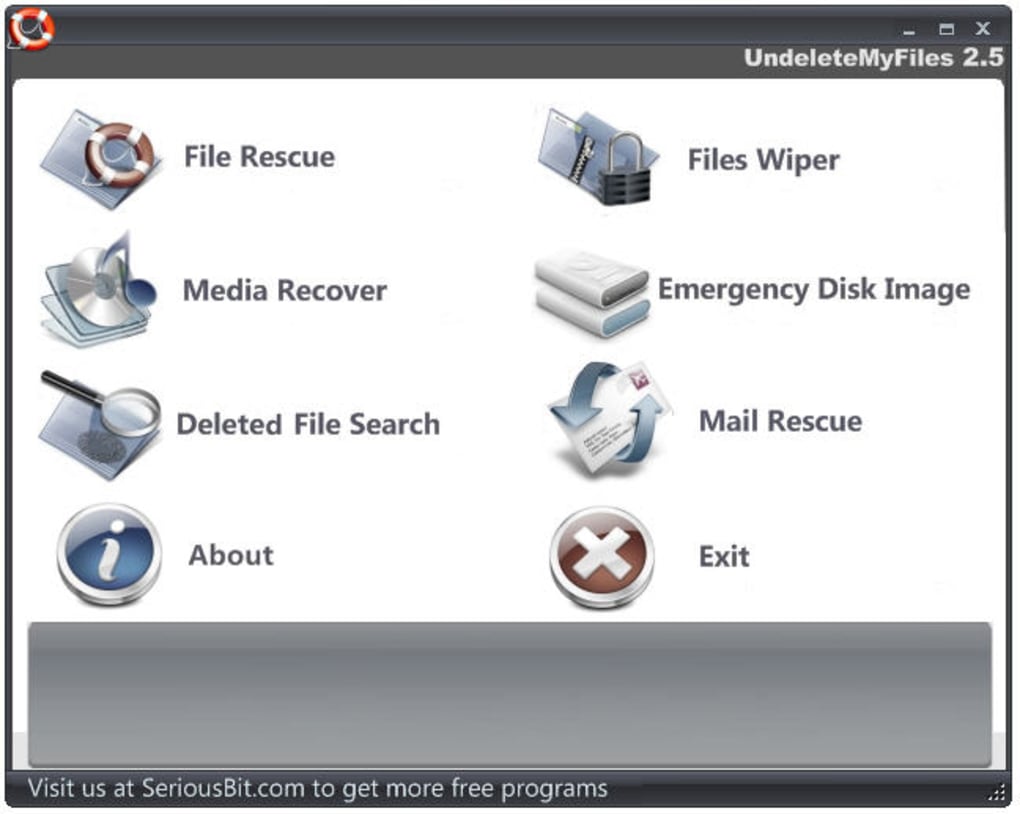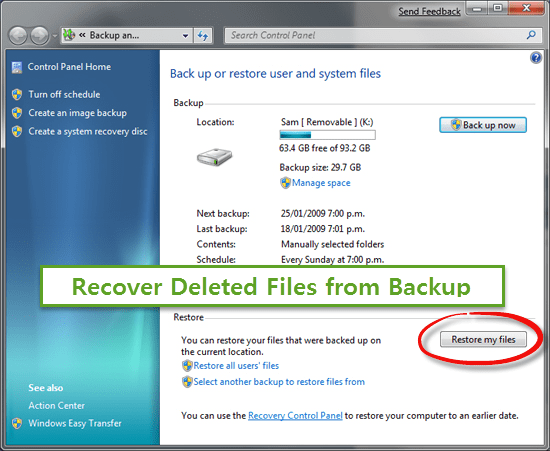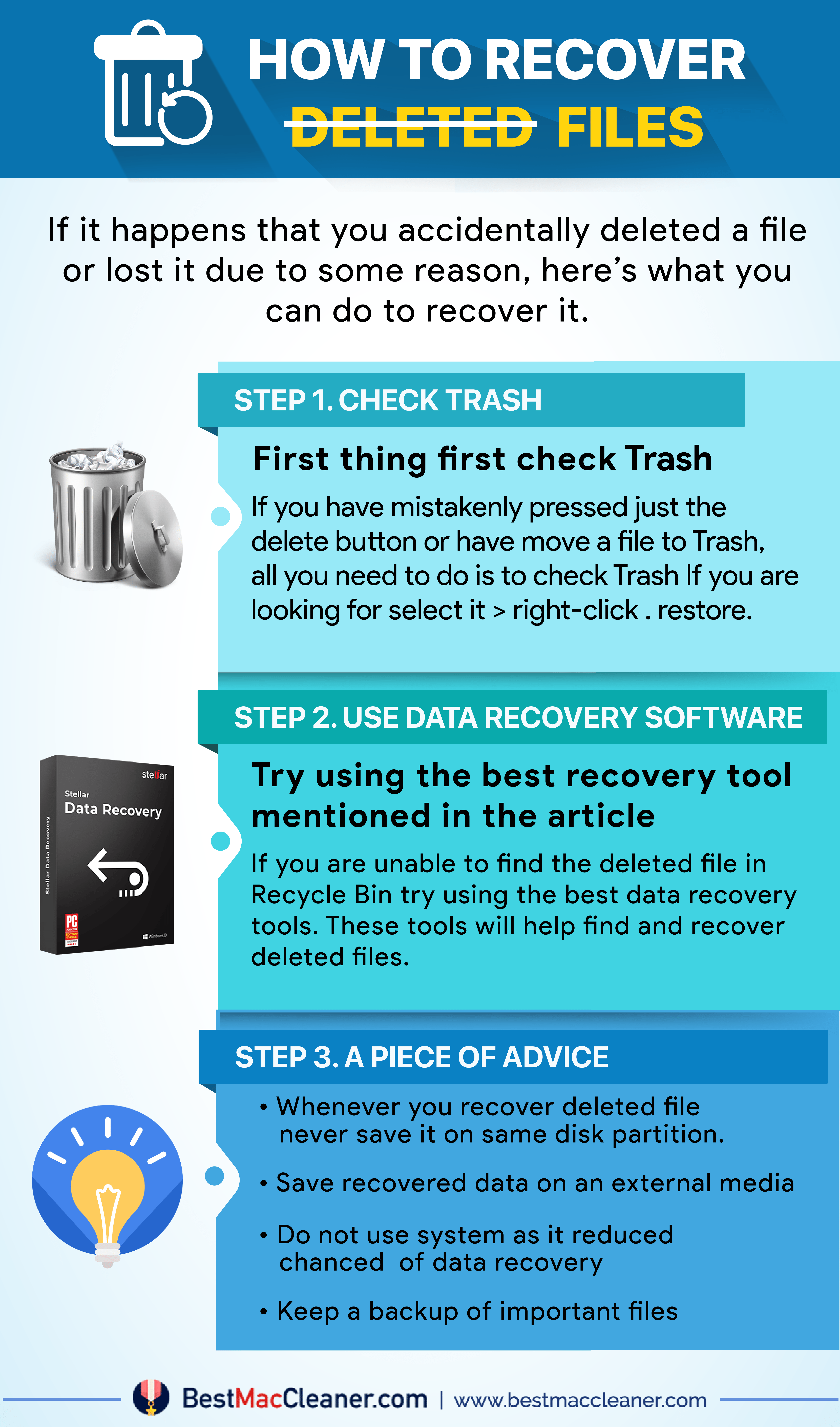Recover Deleted Files Using Mac Terminal. Difficulty: High Chance of success: Moderate Requirements: The deleted files are present in Trash. The Mac Terminal program provides an alternate method of recovering files from your Mac’s Trash. It is a command line way to recover recently deleted files from your computer. Move the mouse over the icon of the trash can in Finder, and you can see the deleted files are listed there. When finding the target files, drag them to the desktop, or right-click on them and select 'put back' to recover deleted files on Mac from the trash. Please note that you have only 30 days to recover files on Mac from the day you deleted. This Mac trash recovery tool is 100% safe for you to recover files from Trash on Mac running macOS 10.12 or above. It can recover files in 200+ formats, restore files lost under different situations, no matter from internal hard drive or external media/sd card storage device. Why Cisdem is picked as the Best Mac Trash Recovery.
Basics of File Recovery
Files in Trash

If you simply put files in the Trash you can restore them by opening the Trash (left-click on the Trash icon) and drag the files from the Trash to your Desktop or other desired location. OS X also provides a short-cut to undo the last item moved to the Trash -press COMMAND-Z.
If you empty the Trash the files are gone. If a program does an immediate delete rather than moving files to the Trash, then the files are gone. Recovery is possible but you must not allow any additional writes to the hard drive - shut it down. When files are deleted only the directory entries, not the files themselves, is modified. The space occupied by the files has been returned to the system as available for storage, but the files are still on the drive. Writing to the drive will then eventually overwrite the space once occupied by the deleted files in which case the files are lost permanently. Also if you save a file over an existing file of the same name, then the old file is overwritten and cannot be recovered.
General File Recovery

Recover Deleted Files From Trash Mac Free Version
If you stop using the drive it's possible to recover deleted files that have not been overwritten by using recovery software such as Data Rescue II, File Salvage or TechTool Pro. Each of the preceding come on bootable CDs to enable usage without risk of writing more data to the hard drive. Two free alternatives are Disk Drill and TestDisk. Look for them and demos at MacUpdate or CNET Downloads.
The longer the hard drive remains in use and data are written to it, the greater the risk your deleted files will be overwritten.
Restore Deleted Files From Recycle Bin
Also visit The XLab FAQs and read the FAQ on Data Recovery.
And the latest edition of Apple's desktop operating system - OS X El Capitan version 10.11 - while not as alluring as candy-coated buttons or as dramatic as major surgery - continues to push the OS forward with a collection of helpful improvements, including better windows management, much improved apps, and broader search capabilities. Apple os x el capitan free download. We've lived 14 years with OS X. (Along with our review, check out ) ProsSplit View and full screen: Much of what's new in El Capitan focuses on how you work with apps and files. Since the release of Mac OS X 10.0 in 2001, we've seen, witnessed a high-stakes heart transplant, and received an informal education in.The steady, not revolutionary, progression of OS X over the past few years reflects a maturing OS. In Yosemite, you can make an app window fill the screen by clicking the green full-screen button in the top-left corner of its window.
Oct 3, 2012 7:48 PM
Recover files that are deleted from Mac Trash with Remo Mac File Recovery Software. Download the free version of Mac File Recov ery tool that recovers and allows free preview of the recovered files from trash in a couple of clicks. Download and try now for free!!!
What after deleting Trash files?
When you delete a file on Mac machine, it simply resides in a folder named as Trash Bin. Therefore, you can restore particular deleted file from the Trash. Now think of same operation but a step ahead that is deletion of file from Trash Bin. In this situation, the only option to save your crucial files, which is already trashed, is the use of a third party data recovery tool. Now it is important to make a selection of an efficient application that ensures perfect deleted Trash recovery on Mac machines.
Remo Recover - Best Mac Recovery Tool to Recover Deleted Files from Trash
There are a variety of tools available on the internet but what makes Remo File Recovery the best undeleter is its amazing efficiency of retrieving deleted data on Mac machines. This sophisticated utility comes with easy to use graphical user interface, hence allowing both novice and professional users to perform recovery operation without any difficulty. It does not matter what is the cause behind the loss of data, the software is capable enough of retrieving deleted files from the Macintosh hard drive after any kind of data loss situation. This software is empowered with advanced drive scanning technology that ensures complete and secure retrieval of Trash deleted files.
This is how user ends with deleting Trash Files!
Generally, user deletes Trash files when they want to free up the disk space occupied with deleted data that is resided in Trash Bin. For this purpose, the user may select 'Empty Trash' option. After this operation no file will remain in the Trash. Deletion of file using “Command+Option+Shift+Backspace' combination lets the file bypass the Trash Bin without any confirmation dialog.

Apart from above stated scenario regarding Trash file deletion, some other reasons which are equally responsible for same accident are pointed here. Some users are habitual of deleting files through the terminal i.e. 'rm –rf ~/. Trash/*' command on the terminal. Through this way, you can make Trash empty as it leads in deletion of all files once you run this command on terminal.
Instant Recovery within few simple clicks!
After getting your important files deleted from Trash, immediately set a plan to execute the rescue operation. Just download and install Remo Recover on your Mac machine and follow a few easy instructions. Your deleted files will be back in just a few mouse clicks. Before saving the restored files, you can preview and sort them based on the file name, size, file type, date, etc. In addition to this, free demo version is also available, so that you can judge the software’s performance at recovery operation.
Unique Application – Unique Features
Have a close look upon eminent features comes with this advanced application:
- Allows user to view restored Trash data in Mac finder styled interface
- Supports deleted file recovery from internal hard drive, external hard disk, USB drives, flash drive, memory sticks, iPods and from other storage drives on Mac computers
- Retrieves from Trash Mac after emptying Trash Bin, Command-Shift-Delete operation or terminal
- Undelete Trash files from FAT 16, FAT 32, HFSX, and HFS+ Mac volume
- Supports deleted Trash file recovery from Macintosh internal hard drive as well as external hard disk
- Recover empty Trash on Mac OS X 10.5 and its above versions such as Mac OS X Lion, Leopard, Snow Leopard etc
Steps to recover deleted files from Mac Trash:
Step 1: Install the trial version of the Remo Mac Trash recovery application on your system and launch it to see the home screen as illustrated in figure 1. Select 'Recover Files' option to proceed further.

Figure 1: Main Screen
Step 2: On the next screen select drive from which you want to rescue deleted files as illustrated in figure 2.
Figure 2: Select Drive
Step 3: Once the recovery process gets over, the list of recovered files will be displayed.
Figure 3: Recovered Files
With 'Secure Empty Trash' Mac users can overwrite the sensitive files and erase these files securely from the drive.